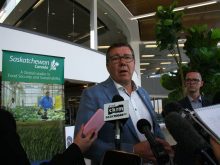The World Trade Organization will soon render its decision on a dispute between China and Australia that could have huge ramifications for Canadian barley exports and prices, says an industry official.
Australia launched the trade dispute with the WTO in December 2020, claiming China’s 80.5 percent tariff on Australian barley was unjustified.
A WTO dispute panel is supposed to issue its final report to the parties in the first quarter of 2023.
“I have no doubt that the WTO ruling will come down in favour of Australia,” said Peter Watts, managing director of the Canadian Malting Barley Technical Centre.
Read Also

Grain firm merger means changes for Canada’s Farm Show
Bunge replaces Viterra on local building, event sponsorship at Canada’s Farm Show.
If that happens, the ramifications will be felt in Canada.
“When the tariffs are lifted, it will definitely have an impact on Canadian barley exports and Canadian barley prices,” he said.
Australian farmers just harvested another bin-busting barley crop, with production exceeding 14 million tonnes for the third consecutive year. A normal crop is eight or nine million tonnes.
The concern is that some of that barley will start flowing into China, displacing Canadian product in this country’s top market.
Canada has benefitted from the de facto ban of Australian barley in the Chinese market.
Canadian exports to China jumped to 3.26 million tonnes in 2020-21, up from 1.44 million tonnes the previous year.
China has accounted for between 85 and 92 percent of Canadian exports in the past three crop years, including the current one. Its imports have been an equal split between malting and feed barley.
“No question that Canada’s barley exports were boosted by the inability of Australia to supply the Chinese market,” said Watts.
Australia has been forced to find new homes for its barley. Sales to markets like Saudi Arabia, Kuwait, Jordan, Japan, Vietnam and the Philippines have exploded since the Chinese ban.
The two years before the ban, Australia exported between 1.58 and 2.51 million tonnes of barley to China. It accounted for about 40 percent of the Asian giant’s imports.
Watts anticipated Australia will slowly regain that market share once the tariffs are eliminated because it is closer to China.
It could take another three months after the final panel report is issued for the dispute settlement body to officially adopt it, according to the WTO’s website.
China could then appeal the ruling, a process that could take another three months or longer.
However, China and Australia could come to an agreement before the final panel report is issued. There has been a thawing of tensions between the two countries.
Watts noted that China’s canola dispute with Canada ended abruptly when China suddenly added Richardson International and Viterra back to its approved exporter list.
“I don’t even know what happened there,” he said.
That is a prime example of how quickly the market dynamics can change.
Canada has been working on ways to soften the blow when it comes by exploring market opportunities with other importers.
For instance, the Canadian Malting Barley Technical Centre is hosting a Latin American Malt Academy this week in Winnipeg.
“That’s part of that diversification push,” said Watts.
The organization wants to expand Canada’s presence in Mexico, Colombia, Ecuador, Peru and Brazil.
It is also working in markets like Vietnam and Japan. Japanese buyers got a scare when Canada had its drought two years ago and are now more eager to stockpile the crop.
















